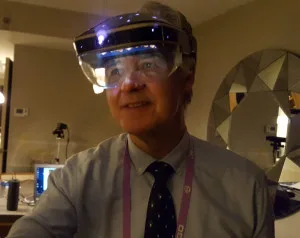Most of my week has been taken up with writing and editing our SID special report, which is a substantial one. However, I also found time, as I was in the San Francisco bay area, to visit the Augmented World Expo in Santa Clara. I will be writing that up over the next couple of days, so that it will be on the website soon, and we’ll include the report in next week’s issue.
In the press room at AWE, we were talking about the development of the market and I had what seemed to me to be a ‘lucid moment’ – it could just have been the coffee, of course. As Norbert has mentioned regularly (he has written quite a lot of our A/R coverage over the last year or two), the A/R market today is in professional applications. It was clear from the exhibitors at AWE that they are also focused on this market and most of the best of the headsets and displays that were on show are aimed at that market.
Professional users are prepared to accept compromises in look or battery life or cost to allow themselves to enter the market, because there is often a clear ROI case – whether that is in speeding an assembly or picking operation, avoiding mistakes, enabling remote collaboration or even saving lives. As a result, they provide real markets for the start-ups and pioneers that form most of the market today.
However, at SID and at AWE, I was also exposed to companies such as Microsoft and Meta that are clearly aimed directly at the consumer market (well, Meta suggests it’s also aimed at corporates, but its approach is totally a consumer-style operation, so if it aims at corporates, I suspect it will fail quickly).
In the longer term, I believe that the A/R market will be a big one, bigger than VR, although that will be bigger, earlier because of gaming. The development of a consumer market for A/R will mean levels of scale and volume that will drive technology and cost reduction dramatically. At the Investors’ Conference, last week, the development of the optics for CDs and DVDs were discussed. These started out as incredibly difficult and expensive sub-systems, with 60 or 70 optical components, but the volume of the market has meant that the cost of such incredible technology has now come down to ‘around $2.00’.
It seems to me, then, that there is a difficult decision for current A/R market participlants. Do they focus on doing a good job for professionals, as many of them are doing? Or do they try to develop a consumer business to get scale? The lesson from the graphics chip business is that scale will be the eventual winner. Companies such as Silicon Graphics and Evans & Sutherland (and many more) that were very active in professional graphics, got wiped out by Nvidia and ATI/AMD that had huge scale from the games business. I suspect that the same may happen in A/R. Those that are able to get the technology good enough and cheap enough will drive costs down so much that eventually they will come back and ‘mop up’ the professional business.
Certainly, I was very impressed by the Microsoft Hololens, although it is not yet ready for consumer adoption, because of weight and cost. However, as I wrote a few weeks ago after visiting Technicolor in Rennes, I am very impressed with the concept of tying in A/R with video and movies as Technicolor is doing at the research level. The idea of characters coming from the TV into the living room, with the visual quality provided by Microsoft, is going to be very compelling.
Bob

